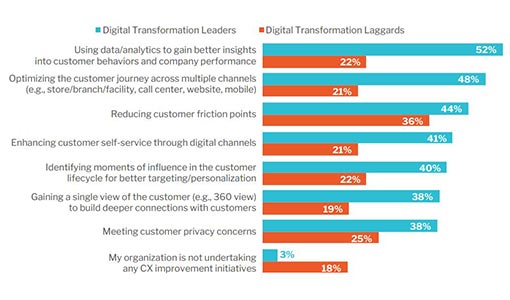The 451 Take
A world of increasingly empowered consumers is putting greater pressure on businesses to deliver content-rich, personalized commerce experiences.
Participating in the ‘experience economy’ means businesses must become more data-driven, with an architectural shift leading to investment in new customer data infrastructure technologies to unify the journey, especially voice-of-the-customer (VoC) tools.
451 Research data has found that companies with a mature outlook on digital technologies are dramatically outpacing their peers in using data to influence experiences. They are finding that they can’t tell a coherent story about the customer’s journey without data to help it make sense. Customer feedback is an essential component of that data landscape.
This stark divide implies that businesses on the wrong side will be under pressure to digitize their customer experience processes. Figure 1 illustrates that digital leaders are far more likely to find value in using data to analyze customer behavior, or to find the moments of leverage that indicate a customer is primed to purchase.
VoC data is a critical component in building experiences and journeys that enhance the customer relationship.
Using Data to Optimize the Customer Journey Separates Digital Leaders From Laggards
Source: 451 Research’s Voice of the Enterprise: Customer Experience & Commerce, Organizational Dynamics & Budgets Q1 2019
Q: Which of the following initiatives is your organization actively pursuing to improve customer experience?

451 Research’s Voice of the Enterprise: Customer Experience & Commerce, Organizational Dynamics & Budgets Q1 2019
More than half (52%) of leaders are using data and analytics for better insights into behaviors and performance, compared to just 22% of laggards. The gap between leaders and laggards in using self-service to reduce friction is 41% to 21%.
This tells us that gathering customer data is a competitive differentiator that allows some companies to build richer experiences while outpacing their less digitally savvy peers.
451 Research is a leading information technology research and advisory company focusing on technology innovation and market disruption.
More than 100 analysts and consultants provide essential insight to more than 1,000 client organizations globally through a combination of syndicated research and data, advisory and go-to-market services, and live events. Founded in 2000, 451 Research is a part of S&P Global Market Intelligence.
Business Impact
Digital leaders are defined as businesses that have formal digital transformation strategies, and digital laggards as those without. The old model for building experiences was to create one story – a basic customer journey – and hope that millions of people experienced it.
Now that resources for extracting and scrutinizing customers’ complex voices are available, businesses have started to apply their new knowledge to building experiences that resonate beyond simple interactions.
Along the way, they are finding that listening to what customers have to say also benefits operations in the form of reduced costs – e.g., in contact centres – with fewer issue escalations.
Leverage All the Data That Is Available.
A company’s own data is the essential resource in closing this divide; it has to be as close to a 360-degree customer view as possible. Feedback data is a key resource in understanding customer intent and behavior.
Personalized experiences (cited by 40% of digital leaders) require a detailed picture of customers’ true feelings.
Modern Technology Innovations Make the Customer Voice More Accessible.
New investments in customer intelligence platforms are needed to address customer demand for new immersive experiences that help businesses build deeper connections and recommend next best actions. For businesses to effectively compete in this shifting environment, they need to capture and act on information.
Automation Is the Answer to Data Overload.
Humans cannot effectively extract meaning from these data pools manually; they need new approaches, especially automated AI and ML techniques, to map customer journeys and translate them into coherent stories/experiences and identify moments of influence.
Because of the vast amounts of available data, businesses should automate much of the analytics process.
Customers’ Journeys Are Complex.
Experiences are so varied – happening in so many online and offline environments and using so many channels – that businesses need centralized systems to organize what customers say and extract the relevant contextual cues that drive successful outcomes.
Omnichannel experiences don’t just happen; they need to be orchestrated. And listened to. To effectively compete in the data-driven experience economy, businesses need to capture, analyze, understand and act on data and content.
Digital transformation efforts are important in bringing that data and analysis directly into the customer’s journey.
Listen for the Customer’s Own Voice.
An experience platform with a VoC focus is the most sensible way to put the pieces together: automated analysis, omnichannel experience management and customer data resources. Across the spectrum of qualities that distinguish digital leaders from laggards, what stands out among leaders is attention to optimizing the journey and reducing friction.
Looking Ahead
With the explosion in new types of physical, digital and blended experiences, customers are increasingly expecting pervasive and seamless experiences both in-store and online, all personalized to their own changing context.
To succeed, businesses need to be more creative in the ways they engage with customers, not only through investment in new technologies such as AI for personalization, but also through commitment to rich personalized storytelling to generate unique experiences that attract and retain customers.
This will lead to a drive toward digital transformation projects that focus specifically on data and experience management capabilities. The divide between leaders and laggards is a window into how competitive those companies are.
Most critically, projects that break down data silos and allow analysts to incorporate more VoC data sources will become high priorities. As customer interactions become more complex and omnichannel, so does the effort to listen to customer voices and transform data into action.
Old-school VoC has mainly been used in the past to identify problems as they arise. With more and better data from customers at the ready, companies can adopt a proactive stance that seems more positive to customers.
This report has been re-published by kind permission of OpenText- View the original post.
Author: Guest Author
Published On: 1st Oct 2021
Read more about - Guest Blogs, OpenText















